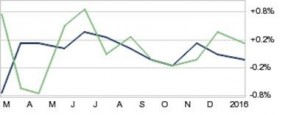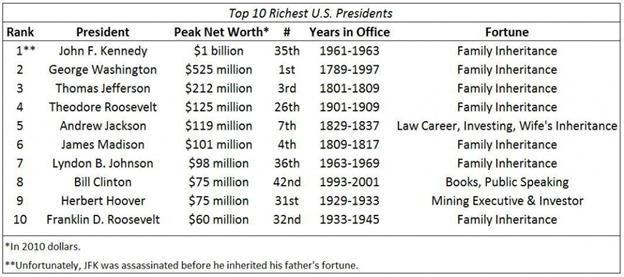Random gleanings from business, investments and economics, Odd Lots
“If GM had kept up with technology like the computer industry has, we would all be driving $25 cars that got 1,000 MPG.” – Bill Gates
Fintrust Investment Commentary
Last week was a week of volatility for stocks and oil.
Note: the curves on those charts are almost identical. As oil prices fared, so fared the stock market.
Other stories of interest from the second week in February:
Car loans on the rise…
Last week the New York Fed released the Household Debt and Credit Report (chart below). The graph below shows that mortgage debt peaked in 2008, but student loans and auto loans are continuing to grow.
A drill-down into the numbers finds that car buyers are borrowing for much longer terms. 30% of all new car loans now last 7 years. Credit analysts are concerned that the cars will be worn out before the loans are paid off.
Comment: Buy auto parts stocks?
Common sense or Artificial Intelligence?
The brakes were applied to driverless cars last week, in a letter sent to Google by the National Highway Traffic Safety Administration. You’ve heard about autonomous cars: driven by computers, not people.
Many of the world’s biggest companies have invested billions of dollars into driverless cars, including Google, Apple, Toyota, Ford, General Motors and Uber.
Engineers say the cars may eventually reduce the number of accidents by 90%, and reduce the cost of transportation by 75%.
Several companies are close to producing cars for the mass market. Driverless cars are beginning to appear on showroom floors.
Last week’s NHTSA letter will slow things down.
We had to read this several times to wrap our minds around it. According to the NHTSA’s interpretation of transportation law, every car on the road must be operated by a licensed driver. But a driverless car doesn’t have a licensed driver…
Last week’s letter states that the legal driver in driverless cars will be Artificial Intelligence. You remember Artificial Intelligence. That’s the intelligence behind the clock you can’t figure out how to reset on your dashboard.
The letter assures that AI cars will be subject to all regulations of the NHTSA.
So many questions are yet to be answered. For example, if AI runs a red light or gets caught speeding, the violation isn’t the passenger’s fault, it is the legal driver’s fault. If the legal driver is AI, who pays the fine? Google?
And what happens if you don’t like the way your AI is driving? Can you over-ride it and take control of the vehicle manually? If you do, who is the legal driver?
The NHTSA wants the industry to slow down and figure some of this stuff out before too many driverless cars hit the road.
Comment: We think AI should be required to stand in line for hours at the Highway Department just to get a bad license photo.
AI will also pay the parking meter
Earlier this month New York Mayor Bill de Blasio announced that New Yorkers will soon be able to pay for parking places with their mobile phones. There’s an app for that. New Yorkers will simply pull into a parking spot, and the app will pay the city automatically.
While it sounds a little like Big Brother, New York drivers are expected to save money. Drivers will no longer have to guess their parking time in advance and stuff quarters into meters. Drivers will be billed only for time parked. Drivers won’t get caught without change, and run the risk of expensive tickets.
The rules will be enforced by Traffic Enforcement Agents using tablet devices.
Comment: Big Meter Maid.
Airlines flying high, and safely…
2015 was one of the safest years ever for flying, according to a report released last week by the International Air Transport Association. Last year’s global jet accident rate was the equivalent of only one major accident for every 3.1 million flights, a 30% improvement over the previous five-year rate.
Comment: With high safety and cheap fuel, this should be the best of times for airlines.
Top 10 Tax Havens
Howmuch.net identified the world’s top tax havens, countries that charge zero personal income tax. These top ten are ranked below by their gross domestic product. #1 is Bermuda.
Not a bad place to escape taxes.
• Bermuda – Personal Income Tax Rate 0% – GDP per capita of $91,479.
• Qatar – Personal Income Tax Rate 0% – GDP per capita of $60,796.
• The Cayman Islands – Personal Income Tax Rate 0% – GDP per capita of $54,827.
• Kuwait – Personal Income Tax Rate 0% – GDP per capita of $30,147.
• United Arab Emirates – Personal Income Tax Rate 0% – GDP per capita of $25,773.
• Brunei – Personal Income Tax Rate 0% – GDP per capita of $25,140.
• Bahamas – Personal Income Tax Rate 0% – GDP per capita of $20,690.
• Bahrain – Personal Income Tax Rate 0% – GDP per capita of $18,128.
• Saudi Arabia – Personal Income Tax Rate 0% – GDP per capita of $17,820.
• Oman – Personal Income Tax Rate 0% – GDP per capita of $12,472.
Comment: The Bahamas have a higher per capita GDP than Saudi Arabia?!
Who was our richest President?
In the spirit of President’s Day, ValueWalk published a table ranking the wealth of America’s richest Presidents. The table is based on information assimilated by 24/7 Wall Street, and adjusted to 2010 dollars.
24/7 Wall Street observed:
“As the focus of the economy has changed, so has the way the presidents made their money.
It is not surprising then to find that the first few presidents — from Washington’s election to about 75 years later — were large landowners.By 1850, beginning with Millard Fillmore, most presidents were lawyers who spent years in public service. They rarely amassed large fortunes, and their incomes were constituted almost entirely of their salaries. These American presidents were distinctly middle class, and they often retired without the means to support themselves in any way close to the presidential lifestyle.
At the end of the 19th century and beginning of the 20th, there was another significant change in the economy. Large, professionally organized corporations in the oil, mining, financial, and railroad sectors allowed individuals to amass large fortunes.
John F. Kennedy was wealthy because of the financial empire built by Joseph Kennedy. Herbert Hoover made millions of dollars as the owner of mining companies. Since the early 20th century, the fortunes of many presidents, including Theodore Roosevelt, Franklin D. Roosevelt, Kennedy, and both George W. and George H.W. Bush were driven by inherited wealth (the Bush family net worth is estimated to be $60 million).”
Comment: If elected, Donald Trump would reset the bar.
The Week Ahead
A shortened week, but plenty of data. Wednesday’s economic numbers are likely to get the most attention from the markets.
Economics

Tuesday: Empire State Manufacturing Index, three Fed regional presidents will be speaking.
Wednesday: Housing Starts, Producer Price Index, Industrial Production, Fed minutes (from the 1-27 FOMC meeting)
Thursday: Jobs data, Index of Leading Indicators, EIA Petroleum status
Friday: Consumer Price Index
Earnings
Tuesday: Agilent, Devon Energy, Express Scripts, Genuine Parts
Wednesday: Barrick Gold, Analog Devices, Dr Pepper Snapple, Gannett, Marriott Int’l, Williams Cos
Thursday: Ambac, Boise Cascade, Cabelas, Duke Energy, Consolidated Edison, Fluor, Freddie Mac, Wal-Mart Stores
Friday: Deere, Fannie Mae, VF Corp, Virtual Piggy


